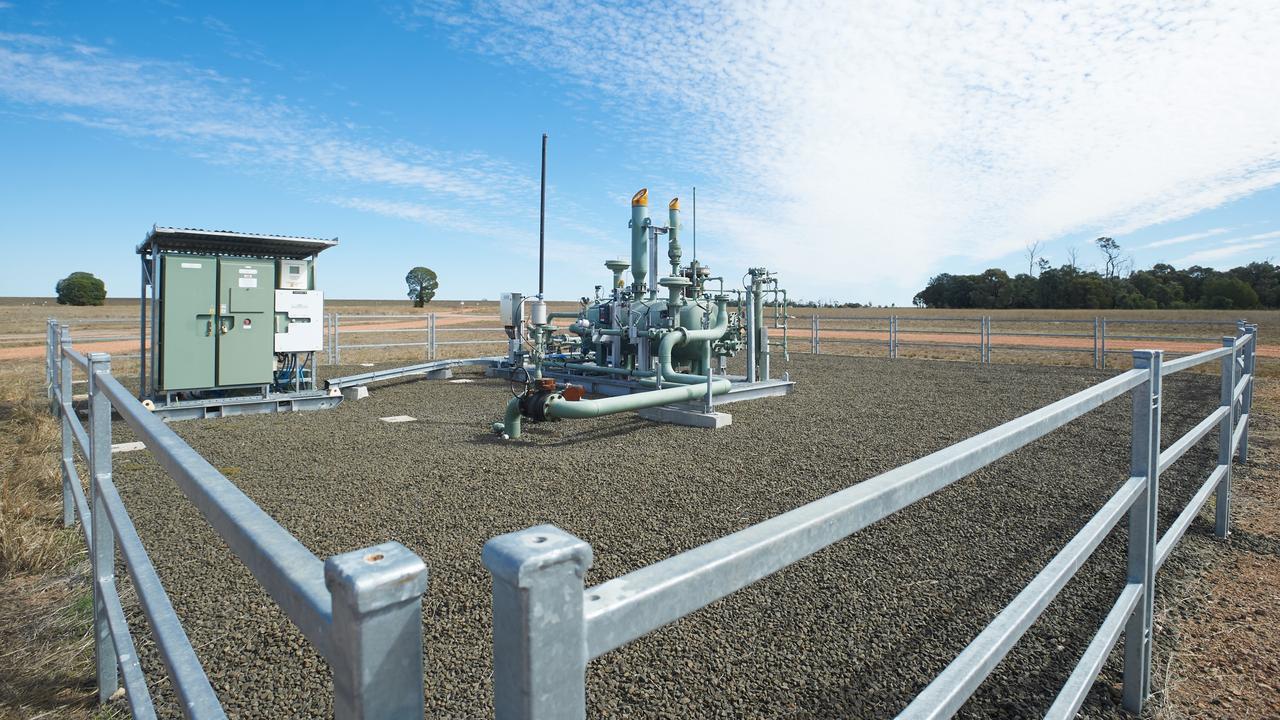‘Exhaustive’ CSIRO study says no plausible pathway for CSG extraction to impact health
Eight groups of chemicals used in the coal seam gas industry have been flagged for further research after an ‘exhaustive’ CSIRO study found no plausible pathway for harm to humans.
Business
Don't miss out on the headlines from Business. Followed categories will be added to My News.
Eight groups of chemicals used in the coal seam gas sector have been flagged for further research into their impact on human health, after an “exhaustive’’ CSIRO study broadly found there was “no plausible pathway” for negative impacts as a result of the industry’s activities.
While the majority of chemicals used in the CSG sector and other impacts such as noise, light and emissions were found not to be a risk to human health, there was a gap in the available data for some chemicals which warranted more study, CSIRO said.
Two new studies have now been started, examining the potential impact of seven chemical groups on human health via soils and groundwater, and another on the analysis of whether airborne silica dust at CSG sites poses a risk.
Some of the chemicals which will be subject of further research include the biocide CMIT which is commonly used as a preservative in cosmetics and laundry products, fluorobenzoic acid tracers, used as tracers in water systems and for which there is limited toxicity data, and polyacrylamide, a polymer used in drilling and hydraulic fracturing.
The respiratory risk from crystalline silica which is used as a proppant in CSG wells will also be studied, given limited data on the silica content of dust on the study sites.
The study, undertaken by CSIRO and the University of Queensland, was carried out on a 2150sq km site in Queensland’s Surat Basin, and examined factors which could pose a risk to health including chemicals, air emissions, noise, light and dust associated with CSG activities.
“While the study found that for the majority of factors there was no plausible pathway to impact human health, it has determined further in-depth assessment of a small number of identified factors is required,’’ CSIRO says.
“Two new CSIRO research projects are now underway as a result and will conduct further in-depth studies focusing on eight groups of chemical factors.’’

CSIRO energy resources research director Dr Damian Barrett said the study provided forensic information about the potential hazards.
“The value of this exhaustive study is that it provides certainty about where we need to focus further research,” Dr Barrett said.
“By ruling out factors of no concern we ensure cost-effective and targeted use of research resources to zero in on chemical factors with a possible pathway for potential impact on human health.
“CSIRO is already taking the next steps to look more closely at these eight groups of chemical factors where a potential pathway can’t be ruled out or more information is needed.”
The study was conducted in the region of Miles, Chinchilla and Condamine, and covered about 2400 gas wells, 5000km of gathering lines, four water treatment plants, eight gas processing plants and 15 compression stations.
The university’s Queensland Alliance for Environmental Health Science (QAEHS) appraised the chemical factors used by industry, while CSIRO completed the assessment of chemical factors associated with air emissions and physical factors (noise, light and dust).
“The study found that for the majority of factors there was no plausible pathway to impact human health,’’ CSIRO said. “Noise and light emissions from CSG activities do not pose a hazard to physical health in the study site. Chemical factors associated with air emissions from CSG activities were within relevant health‐based air quality objectives.’’
Of the 97 unique chemical factors used in CSG drilling and hydraulic fracturing operations, CSIRO said 72 were assessed and found to have low hazard potential to human health, and 25 chemical factors (in eight groups) warrant further assessment. Based on the available evidence, none of these chemicals were found to represent an acute hazard to human health.
A CSIRO extension study examined the microbial degradation of these groups of chemical factors in soil and aquifer samples and found that four chemical groups degraded readily in soils within days, and more slowly in aquifer samples.
The research also included the results of a study looking at the health impacts of additives used in the fracture stimulation of coal seam gas wells, which found that 40 of the 97 chemicals identified as being in use were low hazard such as simple salts and widely used chemicals such as acids.
For a number of the remaining chemicals the study flagged eight for further assessment.
The study said the majority of wells in the study were not fracture stimulated as they were highly productive without requiring this procedure to be carried out.
CSG has been commercially extracted in the study area since 2013 as part of the Australia Pacific Liquefied Natural Gas (APLNG) project owned by Origin Energy, ConocoPhillips and Sinopec, and Shell’s Queensland Gas Company LNG project.
On the emissions front, the study says “The CSG industry is a source of potentially hazardous emissions to air of known pollutants.
“Available data from a number of sources indicates the levels of these chemical factors in air at the study site are within air quality objectives and are unlikely to pose a hazard to human health.’’
The study was funded by the Queensland (59 per cent) and federal governments (21 per cent) and CSIRO (18 per cent).
More Coverage
Originally published as ‘Exhaustive’ CSIRO study says no plausible pathway for CSG extraction to impact health









